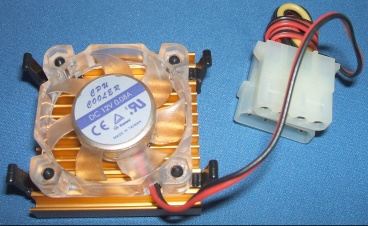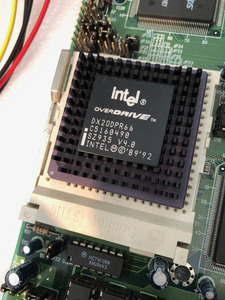zuldan wrote on 2023-12-22, 12:11:
I have a couple of overdrive CPUs that get a little too hot for my liking. For a standard 486 you can simply buy a heatsink and fan that clips onto the CPU (https://www.ebay.com.au/itm/185840766419), however the overdrive already has a heatsink so the heatsink clip won’t work. Is there a way to attach some sort of fan to it?
Hi there, you can try out different things if you like.
a) If the fins of the cooler (heat sink) are long enough, you can screw the fan directly onto the CPU.
Use plastic screws if you're worried of damaging something.
You can also rotate the fan, if needed, so that merely two mounting holes are over the heat sink fins.
That might be necessary, depending on the size of the fan.
Ideally, the fan should suck the heat away from the CPU. But in reality, it doesn't really matter that much, aslong as there's an airflow.
b) You can use a bit (just a bit, a small line or a few dots) of hot glue on the side of the CPU/slot to attach the fan.
If done carefully, it's not a permanent installation and the fan can removed again later on.
Btw, a bigger and slower fan has some advantages over a tiny CPU fan.
a) It draws less current
b) It's more efficient, moves more air
c) It is quiter, usually (at same performance if the tiny one)
The power requirements of small high-speed fans is not to be underrated.
In a small 286 PC (pizza box) with a custom PSU, using such a small CPU fan would technically overburden the PSU.
I'm speaking under correcting here, of course.
That's merely what came to mind. I've mounted fans that way before, but there might be more elegant solutions.
PS: There's also a software-solution to keep the CPU temperature down during idling.
DOSIDLE, an utility, does put the CPU to sleep if there's nothing to do. It uses HLT instruction directly or APM BIOS.
For Windows 3.1, there's WQGHLT (uses HLT).
For Windows 9x, there's AmnHLT.
They're primarily being used to keep VMs from causing a 100% CPU load all the time.
But they're also working fine with real hardware.
DOSIDLE can be fine tuned, even, so that the idle loop detection has the correct intensity (for games etc).
Edit: Here's an example picture of a 486 era cooling fan that's screwed directly to the heat sink..
The screws do go between the fins, while the little plastic clamps hold onto the CPU.

Source: http://www.cjemicros.co.uk/micros/individual/ … de=VAR-CPUHSFAN
"Time, it seems, doesn't flow. For some it's fast, for some it's slow.
In what to one race is no time at all, another race can rise and fall..." - The Minstrel
//My video channel//


